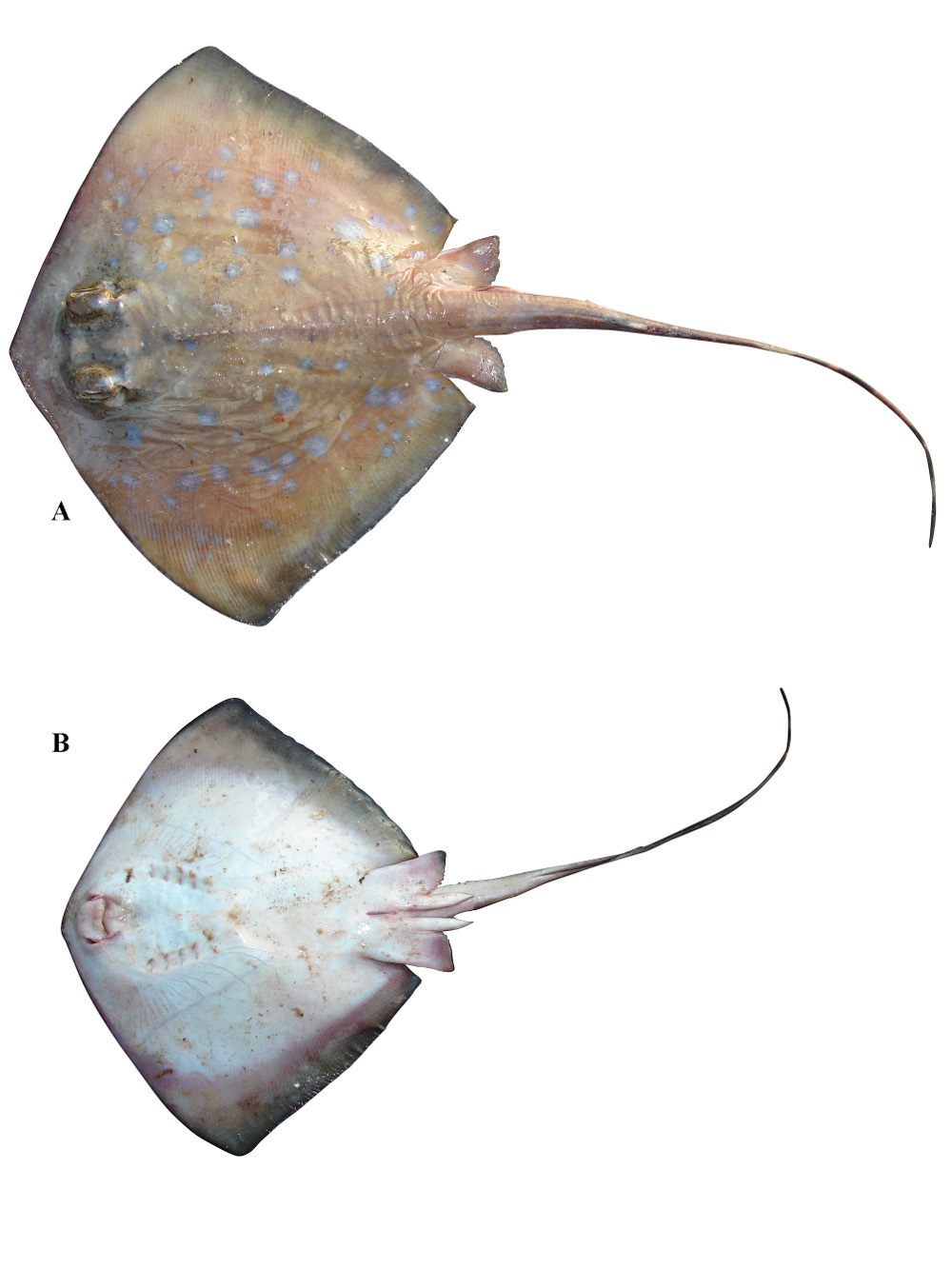Neotrygon orientale
Last, White & Séret, 2016
Classification: Elasmobranchii Myliobatiformes Dasyatidae
Reference of the original description
Taxonomic status of maskrays of the Neotrygon kuhlii species complex (Myliobatoidei: Dasyatidae) with the description of three new species from the Indo-West Pacific. Zootaxa, 4083(4), 533–561
Taxonomic status of maskrays of the Neotrygon kuhlii species complex (Myliobatoidei: Dasyatidae) with the description of three new species from the Indo-West Pacific. Zootaxa, 4083(4), 533–561
Types
Neotrygon orientale
Holotype: MZB: unreg (ex CSIRO H 7858-01); Paratype: CSIRO: H 6130-01; CSIRO: 6136-01; CSIRO: 6136-04; CSIRO: H 7099-09; CSIRO: H 7848-01;
Neotrygon orientale
Holotype: MZB: unreg (ex CSIRO H 7858-01); Paratype: CSIRO: H 6130-01; CSIRO: 6136-01; CSIRO: 6136-04; CSIRO: H 7099-09; CSIRO: H 7848-01;
Description :
Citation: Neotrygon orientale Last, White & Séret, 2016: In: Database of modern sharks, rays and chimaeras, www.shark-references.com, World Wide Web electronic publication, Version 01/2026
Please send your images of "Neotrygon orientale" to info@shark-references.com

Holotype of Neotrygon orientale sp. nov. (MZB unreg [ex CSIRO H 7858-01]), late-adolescent male 213 mm DW) from South Kalimantan, Indonesia (fresh): (A) dorsal view; (B) ventral view.

Holotype of Neotrygon orientale sp. nov. (MZB unreg [ex CSIRO H 7858-01]), late-adolescent male 213 mm DW) from South Kalimantan, Indonesia (fresh): (A) dorsal view; (B) ventral view.
Common names
Oriental Bluespotted Maskray
Oriental Bluespotted Maskray
Short Description
Original Diagnosis after Last, White & Séret, 2016 [23790]: A small Neotrygon of the kuhlii-complex (reaching at least 38 cm DW; males maturing at 22 cm DW) with the following combination of characters: disc much broader than long, width 1.2–1.3 times length; pectoral apices abruptly angular; snout fleshy, broadly rounded to weakly angular, angle 124–129°, length 1.9–2.5 times interorbital width; maximum width relatively well forward on disc, length from snout tip to pectoral-fin insertion 1.8–2 times and disc width 2.7–2.9 times horizontal distance from snout tip to maximum disc width; preoral length 1.8–2.2 times mouth width; internasal distance 1.3–1.6 in prenasal length; interspiracular distance 13–16% DW; nostril length 3.1–3.8% DW; nasal curtain width 8.9–10% DW; small mouth, width 7–7.5% DW; horizontal distance from cloaca to caudal sting base 48–56% of disc length; thornlets present in nuchal region and weakly developed in the lumbar regions in adults, absent from tail in all sizes; minute, widely-spaced dermal denticles present on mid-disc of large adults; pectoral-fin radials 105–110; total vertebral centra (including synarcual) 125–141, trunk centra (including synarcual) 36–42; blue spots on disc moderately large, largest 0.5–0.9 in eye width; few blue spots on medial belt, 0–6 (mean 0.4), largest 2.8–3.3% DW; mask-like marking rather pronounced, covered with dark peppery spots; ventral surface of disc with diffuse greyish submarginal bands; ventral tail fold dusky with darker edge.
Original Diagnosis after Last, White & Séret, 2016 [23790]: A small Neotrygon of the kuhlii-complex (reaching at least 38 cm DW; males maturing at 22 cm DW) with the following combination of characters: disc much broader than long, width 1.2–1.3 times length; pectoral apices abruptly angular; snout fleshy, broadly rounded to weakly angular, angle 124–129°, length 1.9–2.5 times interorbital width; maximum width relatively well forward on disc, length from snout tip to pectoral-fin insertion 1.8–2 times and disc width 2.7–2.9 times horizontal distance from snout tip to maximum disc width; preoral length 1.8–2.2 times mouth width; internasal distance 1.3–1.6 in prenasal length; interspiracular distance 13–16% DW; nostril length 3.1–3.8% DW; nasal curtain width 8.9–10% DW; small mouth, width 7–7.5% DW; horizontal distance from cloaca to caudal sting base 48–56% of disc length; thornlets present in nuchal region and weakly developed in the lumbar regions in adults, absent from tail in all sizes; minute, widely-spaced dermal denticles present on mid-disc of large adults; pectoral-fin radials 105–110; total vertebral centra (including synarcual) 125–141, trunk centra (including synarcual) 36–42; blue spots on disc moderately large, largest 0.5–0.9 in eye width; few blue spots on medial belt, 0–6 (mean 0.4), largest 2.8–3.3% DW; mask-like marking rather pronounced, covered with dark peppery spots; ventral surface of disc with diffuse greyish submarginal bands; ventral tail fold dusky with darker edge.
Remarks
shark-references Species-ID=14549;
shark-references Species-ID=14549;
Parasites (arranged by Jürgen Pollerspöck)
Cestoda
Cestoda
- Barbeaucestus jockuschae Caira, Healy, Marques & Jensen, 2017 [25321]
















